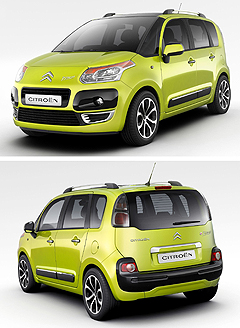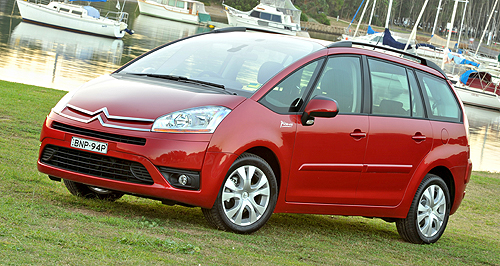Make / Model Search
New models - Citroen - C4 PicassoCitroen repaints Picasso with green splashSolo Picasso: Citroen has simplified C4 Picasso to a single model. Torque takes a hit but economy improves as Citroen pares Picasso range21 May 2010 By TERRY MARTIN CITROEN has pared its C4 Picasso people-mover range to a single variant for the 2010 model year, with the upgrade bringing a new six-speed automated manual transmission with a revised 2.0-litre turbo-diesel engine. The combination sees the Picasso’s average fuel consumption figure fall from 7.4 litres per 100km to 6.0L/100km, which according to Citroen makes it the most economical seven-seat people-mover available on the Australian new-vehicle market. Carbon dioxide emissions also take a tumble from 195 grams per kilometre to 153g/km. Now priced from $45,990 (plus statutory and dealer charges), which is a $1000 increase over the outgoing model, the 2010 Picasso returns 7.7L/100km on the urban test cycle, dropping to 5.0L/100km on the open road. The new EGS electronic gearbox system has a big influence on the improved economy, along with modifications to the 2.0HDi common-rail turbo-diesel engine, which continues to produce 100kW of power at 4000rpm but now develops a significant 50Nm less torque – down from 320Nm to 270Nm, available (as before) from 2000rpm. Citroen says the revised engine features a new-generation injection system and variable-geometry turbocharger. It takes 12.5 seconds for the 2010 Picasso to accelerate from 0-100km/h, which is the same time it took the outgoing 2.0-litre HDi variant relying on a conventional six-speed automatic. In announcing the model changes this week, Citroen claims the Picasso’s economy outperforms all diesel rivals including the Volkswagen Caddy Life and Caravelle, Dodge Journey, Chrysler Grand Voyager and Hyundai iMax, as well as the petrol-powered Kia Rondo, Honda Odyssey, Toyota Avenis and Tarago, Mitsubishi Grandis and the market-leading Kia Carnival, which returns 11L/100km.  Left: Citroen C3 Picasso. Left: Citroen C3 Picasso.Citroen Australia’s list fails to mention perhaps its most obvious rival, the seven-seat Renault Grand Scenic, which uses a 98kW/191Nm 2.0-litre petrol engine and, according to the federal government’s Green Vehicle Guide, returns 8.8L/100km and 210g/km. The C4 Picasso has a five-star rating from the independent NCAP crash-test regime and its standard safety equipment continues to include seven airbags (adaptive twin front, driver’s knee, front side and full-length curtain airbags), seven lap-sash seatbelts (all linked to audible and visual warning indicators), front seatbelt pretensioners and load limiters, a second interior rear view mirror for back-seat surveillance, and anti-pinch functions on the windows and shutter blinds. ABS brakes with EBD and brake assist, and electronic stability and traction control are also fitted standard. Other features included in the price are 17-inch alloy wheels, roof-rails, rear parking sensors, an electronic park brake, cruise control, dual-zone climate-control air-conditioning and various underfloor storage compartments (among a vast array of clever stowage and practical packaging features). Metallic paint requires a further $700 outlay, a panoramic sunroof is available for $1750, and a $5900 premium pack is also available. The latter includes full leather upholstery, chrome detailing, ‘piano lacquer’ trim for the dashboard and doors, electric heated front seats (with driver’s memory settings), deep-pile carpet mats, flat-folding wing mirrors and unique cabin lighting. Other options include an opening tailgate window and Bluetooth hands-free mobile phone connectivity. Citroen will be hoping the 2010 model will boost the C4 Picasso’s fortunes in Australia, with sales to the end of April down 42 per cent compared with the first four months of 2009 – in a market segment (people-movers under $55,000) that is up 41.8 per cent year to date. The pared-back C4 Picasso series will serve to simplify Citroen’s sales and marketing messages for the slow-selling model, which launched in Australia three years ago with a range of petrol and diesel engines. It also leaves room for a forthcoming automatic version of the smaller C3 Picasso, while a Citroen version of Mitsubishi’s ASX compact SUV is also under consideration for release in Australia from around 2012. “The 2010 version ... maintains everything that families really need in a car: space, versatility, safety and security, but it does it within a package that is more compact, more economical and more environmentally friendly than the sort of cars that many families presently use,” said Citroen Australia general manager Miles Williams. “With a combined fuel consumption figure of just 6.0 litres per 100km, it has the ability to beat many small cars, let alone its seven-seat people-mover rivals. “It has benchmark safety and emissions performance, and it keeps all the family-friendly features that have made it an award-winning people-mover.”  Read more8th of July 2008  First look: Citroen's Picasso stoops to C3 levelCitroen surprises with a boxy but tasty new compact people-mover, the C3 Picasso19th of May 2008  Citroen cuts Picasso pricingCitroen prices diesel Picasso under $40,000, saving $4000 for the month of May only12th of November 2007  Citroen fuels thoughtCitroen improves Picasso's specs and throws in $1000 of fuel, as Berlino gains a doorAll new models Alfa Romeo Alfa Romeo Abarth Abarth Alpine Alpine Alpina Alpina Audi Audi Aston Martin Aston Martin BMW BMW Bentley Bentley Chery Chery Brabham Brabham Chrysler Chrysler Chevrolet Chevrolet Cupra Cupra Citroen Citroen DS DS Dodge Dodge Fiat Fiat Ferrari Ferrari Foton Foton Ford Ford Great Wall Great Wall FPV FPV Haval Haval GWM GWM Honda Honda Holden Holden Hyundai Hyundai HSV HSV Isuzu Isuzu Infiniti Infiniti Jeep Jeep Jaguar Jaguar Lamborghini Lamborghini Kia Kia LDV LDV Land Rover Land Rover Lotus Lotus Lexus Lexus Maserati Maserati Mahindra Mahindra McLaren McLaren Mazda Mazda Mercedes-Benz Mercedes-Benz Mercedes-AMG Mercedes-AMG Mini Mini MG MG Nissan Nissan Mitsubishi Mitsubishi Pagani Pagani Opel Opel Porsche Porsche Peugeot Peugeot Ram Ram Proton Proton Rolls-Royce Rolls-Royce Renault Renault Saab Saab Rover Rover Smart Smart Skoda Skoda Subaru Subaru SsangYong SsangYong Tesla Tesla Suzuki Suzuki Toyota Toyota Volvo VolvoMotor industry news |
|










Facebook Twitter Instagram